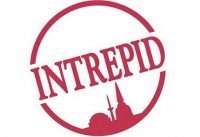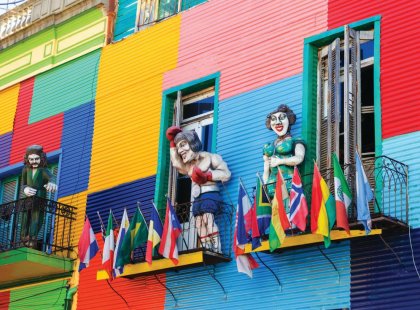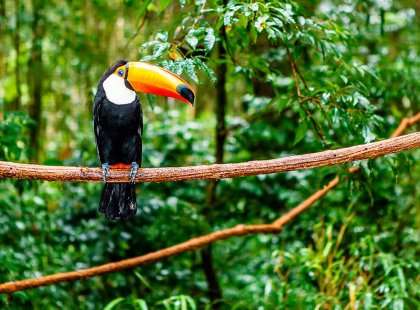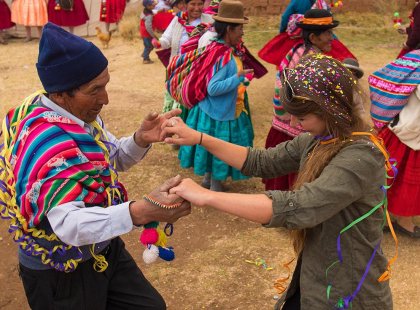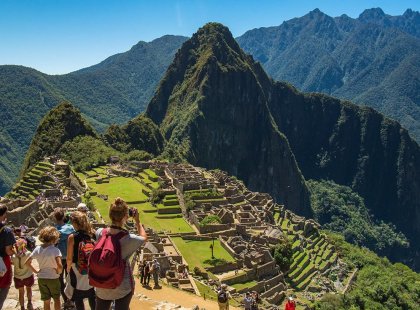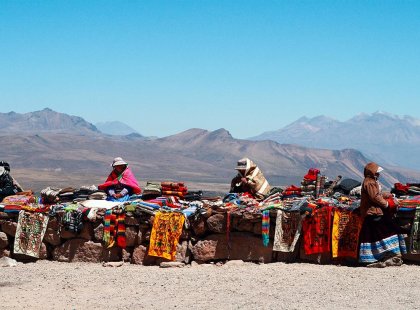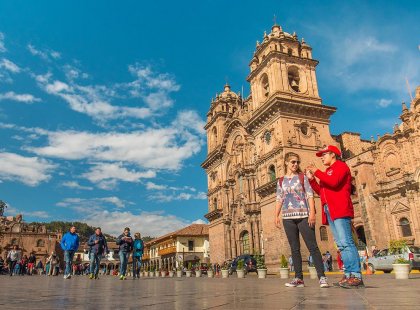Ultimate Peru, Argentina & Brazil
30 days
From
$ 6584
Duration30 days
Discover the delights of South America in Peru, Argentina and Brazil. There are many sides to South America, from the energy of the cities, the beauty of the lansdcapes and the spirit of its people. Discover it all on this trip that winds through the Inca heartlands and jungles of Peru, the enigmatic cities and natural wonders of Argentina and the dynamism of Brazil's vivacious Rio. See animals, meet locals, traverse trails and marvel at all the contrasts of this very special corner of the world.
-
Duration: 30 daysService level: Standard
-
Physical Grading: Demanding
-
Ends in: Rio de JaneiroAges: 15+
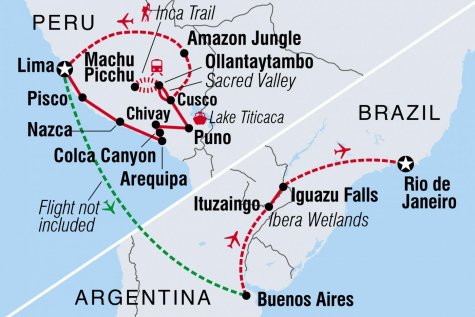
Itinerary
Day 1: Lima
Welcome to Lima, Peru. Your adventure begins with a welcome meeting at 4 pm. Please look for a note in the hotel lobby or ask the hotel reception where it will take place. One of the most beautiful cities in South America, there's plenty to do and see in Lima. You’ll get to see downtown Lima and the historical centre on your walking tour tomorrow, but we also recommend arriving a few days early to see more of the sights. There’s the famous suburb of Miraflores, Central Park and Lovers’ Park, and the 16th-century monastery of San Francisco with its catacombs of some 10,000 remains. There are also plenty of museums including the Museum of the Inquisition, the National Museum and the Gold Museum. Be sure to have a bite of Peru's national dish of ceviche.
Day 2: Pisco
Set out on a guided tour of downtown Lima, where streets are flanked with colonial mansions, palaces and churches. See the iconic Plaza Mayor with its imposing Cathedral on foot, then board a local bus bound for Pisco. The bus will stop about three or four times along the way during the four hour journey. There are no planned activities upon arrival in Pisco, but you may want to seek out a bar serving Peru's national libation – this is the birthplace of the Pisco sour, after all.
Meals: B
Day 3: Nazca
A haven for birdlife, wildlife enthusiasts can opt to visit the Paracas National Reserve this morning for a chance to spot pelicans, red-footed boobies and flamingos on a two-hour boat tour. Otherwise, take it easy do some more sightseeing in Pisco before the drive to one of the world's most mysterious archaeological sites, the Nazca Lines. Along the way, stop in the town of Huacachina. This little settlement sits beside a small lake with dramatic sand dunes. Perhaps go sand-boarding or simply enjoy the photo opportunities. Upon arrival, explore the eerie desert graveyard of Chauchilla, where the arid conditions have naturally interred the remains of the Nazca people buried here. Visit the Nazca lines, enormous geoglyphs representing animals drawn into the sand thousands of years ago. Climb to the viewing platform, or perhaps take an optional flight over the lines for the best experience.
Meals: B
Day 4: Arequipa
Travel about nine hours from Nazca to Arequipa by local bus. Standing at the foot of El Misti Volcano and oozing the best of Spanish colonial charm, Arequipa vies with Cusco for the title of Peru's most attractive city. Built out of a pale volcanic rock called sillar, the old buildings dazzle in the sun, giving the city its nickname - the 'White City'. The main plaza, with its cafes and nearby cathedral, is a lovely place to while away the day.
Meals: B
Day 5: Arequipa
Spend the day in stunning Arequipa. Perhaps wander the main plaza with its lovely cathedral, many cafes and eateries. You may like to visit the Juanita Museum, which houses Peru’s famous ‘Ice Maiden’, the Inca mummy of a girl who died in the 1440s. There’s also the Monasterio de Santa Catalina, a 16th century monastery which only accepted women from well-to-do Spanish families. These nuns grew infamous for their luxurious lifestyles, each one having her own servant, splurging on fine products and enjoying frequent parties.
Meals: B
Day 6: Colca Canyon
Today we travel about five hours by minivan to the town of Chivay. Along the way, you’ll see llamas, alpacas and vicunas – not sure how to differentiate between these adorable creatures? Your tour leader will explain the differences between them. You’ll also stop for breaks, photo opportunities and to try some local coca tea. The third stop takes you to the highest point on the tour at Patapama (4800 metres above sea level) before descending to your destination of Chivay. The town will be your base for exploring the Colca Canyon in the coming days.
Break for lunch in town and then go on a short trek in the area which will take you to the local thermal baths. From here you can either spend the evening soaking in the baths, dining on llama steak at a nearby restaurant or seeing some live Andean music at a pena (local bar).
Break for lunch in town and then go on a short trek in the area which will take you to the local thermal baths. From here you can either spend the evening soaking in the baths, dining on llama steak at a nearby restaurant or seeing some live Andean music at a pena (local bar).
Meals: B
Day 7: Colca Canyon (Home stay)
Wake up early to visit the Colca Canyon. More than twice as deep as the Grand Canyon, the Colca has some breathtaking views. Here you’ll see terraced crops that have been cultivated since pre-Inca times by local villages. This is also the home of the Andean condor. Witness one of the world’s largest flying birds soar above and below you from a prime viewing point above the canyon. Later in the afternoon, visit a Colca Canyon community and meet your homestay host family. You might like to offer to help your host family with their daily activities such as planting, collecting water, peeling potatoes or preparing the family meal.
Meals: B, D
Day 8: Puno
Say goodbye to your host family and board a bus for Puno. It’s a long drive (about five hours), but the dramatic views of Peru’s highlands, the Altiplano, make it an exceptionally scenic one too. Puno is located on the shores of Lake Titicaca, which you’ll explore in the coming days. Upon arrival, take the change to get aquainted with the town; Puno is known as Peru’s folklore capital. This is due in no small part to its thriving indigenous cultures, including the Aymara and Quechua. If you’re lucky enough to arrive during a festival, you’ll be treated to an elaborate parade of costumes and dances.
Meals: B
Day 9: Lake Titicaca (Home stay)
Start the day with a tour of Lake Titicaca. Sitting 3820 metres above sea level, it holds the title of highest navigable lake in the world. Hop in a motorboat and learn about the spiritual significance the lake holds for the Quechua while cruising across its waters. Stop off at Uros Titinos, floating man-made islands made entirely from reeds and home to several families. Later, head to your homestay in the Lake Titicaca region. To get a better understand of daily life, why not help your host family with some of their daily activities. Your hosts will be happy to teach you a few words of their language, Quechua. A friendly game of soccer may also be on the cards.
Meals: B, L, D
Day 10: Puno
After breakfast, take a one-hour boat ride to Taquile Island. The locals here make their livelihood out of textiles, with the women doing the spinning and men doing the knitting. Browse the handmade goods sold here including warm, high quality items. Next, take an uphill trek for about an hour to visit the main area of the island. After a brief stay, the boat will take you back to Puno (about three hours).
Meals: B
Day 11: Cusco
Take a scenic bus ride across the Altiplano towards Cusco (about seven hours). Cusco is the continent’s oldest continuously inhabited city and here, colonial buildings are built upon foundations remaining from Inca times. Spend a little time acclimatising to the high altitude (3450 metres), then set out to discover some of Cusco's lesser-known sights on a guided walking tour. Visit the facade of Qoricancha temple, San Pedro market, the main square, 12 Angled Stone, Regocijo Square and San Blas Square. End the walking tour at Cusco's Chocolate museum where you'll get to sample a decadent cup of hot chocolate made from local cacao beans. There’s a small store where you can browse handicrafts and artisanal chocolate products.
Meals: B
Day 12: Cusco
Enjoy a free day in Cusco, the heart and soul of Peru. You may like to visit the city’s many museums and archaeological sites with a boleto turistico (tourism ticket). This includes the Contemporary Art Museum, Regional History Museum, Qosqo Native Art Museum and the Inca ruins of Saqsaywaman, Q'enqo, Pica Pakara, Pisac and Ollantaytambo. The most easily accessible among these sites is Coricancha, which was once the Incan empire's richest temple until the Spanish built a Dominican church on top of it.
Meals: B
Day 13: Inca Trail, Inca Quarry trail or Train option
Depending on the travel arrangements you made before the trip, during the next four days you’ll be doing one of the following: hiking the Classic Inca Trail, hiking the Inca Quarry Trail or staying in Cusco for another two days before taking the train to Aguas Calientes. While away from Cusco, the bulk of your luggage will be stored at your hotel. If you’re hiking the Inca Trail or the Inca Quarry Trail, the evening before you leave Cusco you'll receive a small duffle bag to carry your clothes in for the next four days (5 kg maximum).
Your team of porters will carry these bags for you, together with the food and equipment for the trail. Please note that you won't have access to these items until the end of each day, as the porters will always be ahead of the group. If you’re travelling to Aguas Calientes by train, you'll be able to leave most of your luggage at the hotel in Cusco and only travel with the necessary items during the excursion by train.
Route 1 Classic Inca Trail:
Today travel by minivan to the 82 km marker and meet your crew of local porters, cook and guide. The first day includes uphill trekking to the campsite, which is at 3100 metres above sea level. On the way you’ll see the Inca sites of Ollantaytambo, Huillca Raccay and Llactapata, as well as incredible views of snow-capped Veronica Peak. In the evening, unwind at the campsite with a nourishing meal.
Notes: The Inca Trail is within the abilities of most reasonably fit people, but please come prepared, as the trail is 45 km long and often steep. Each day's journey generally consists of seven hours of walking (uphill and downhill), with stops for snacks and lunch. Trekking usually begins at 7 am (except on the fourth morning) and you reach the campsite around 5 pm. Accommodation on the trek is camping (three nights). Double tents (twin-share) and inflatable camping mats will be provided. The porters will set up the tents while the cook prepares meals.
Route 2 Inca Quarry Trail:
Make an early start today and drive to Choquequilla, a small ceremonial place where Incas worshipped the moon. Drive to the starting point of the trek, Rafq'a, and meet the horsemen who join us on the hike. After an hour’s walk, reach the small community of Socma. Carry on to the Perolniyoc cascade lookout, an opportunity to stop for photos and a food break. Continue to the campsite, which is 3700 metres above sea level. You should reach the campsite around lunchtime. After lunch, set off to explore the Q'orimarca archaeological site, which once served as a checkpoint to the Incas.
Notes: The Inca Quarry Trail is within the abilities of most reasonably fit people. The hike is 26 km long in total and its highest pass is at 4450 metres above sea level. Throughout the trek, horses will carry your gear and camping equipment. The first two nights are spent camping and the third night you will stay at a simple hotel. Double tents (twin-share) and inflatable camping mats will be provided. The porters will set up the tents while the cook prepares meals.
Route 3 Train:
For those travellers disinterested in hiking the trail or who are unable to, you will spend an extra day in Cusco.
Your team of porters will carry these bags for you, together with the food and equipment for the trail. Please note that you won't have access to these items until the end of each day, as the porters will always be ahead of the group. If you’re travelling to Aguas Calientes by train, you'll be able to leave most of your luggage at the hotel in Cusco and only travel with the necessary items during the excursion by train.
Route 1 Classic Inca Trail:
Today travel by minivan to the 82 km marker and meet your crew of local porters, cook and guide. The first day includes uphill trekking to the campsite, which is at 3100 metres above sea level. On the way you’ll see the Inca sites of Ollantaytambo, Huillca Raccay and Llactapata, as well as incredible views of snow-capped Veronica Peak. In the evening, unwind at the campsite with a nourishing meal.
Notes: The Inca Trail is within the abilities of most reasonably fit people, but please come prepared, as the trail is 45 km long and often steep. Each day's journey generally consists of seven hours of walking (uphill and downhill), with stops for snacks and lunch. Trekking usually begins at 7 am (except on the fourth morning) and you reach the campsite around 5 pm. Accommodation on the trek is camping (three nights). Double tents (twin-share) and inflatable camping mats will be provided. The porters will set up the tents while the cook prepares meals.
Route 2 Inca Quarry Trail:
Make an early start today and drive to Choquequilla, a small ceremonial place where Incas worshipped the moon. Drive to the starting point of the trek, Rafq'a, and meet the horsemen who join us on the hike. After an hour’s walk, reach the small community of Socma. Carry on to the Perolniyoc cascade lookout, an opportunity to stop for photos and a food break. Continue to the campsite, which is 3700 metres above sea level. You should reach the campsite around lunchtime. After lunch, set off to explore the Q'orimarca archaeological site, which once served as a checkpoint to the Incas.
Notes: The Inca Quarry Trail is within the abilities of most reasonably fit people. The hike is 26 km long in total and its highest pass is at 4450 metres above sea level. Throughout the trek, horses will carry your gear and camping equipment. The first two nights are spent camping and the third night you will stay at a simple hotel. Double tents (twin-share) and inflatable camping mats will be provided. The porters will set up the tents while the cook prepares meals.
Route 3 Train:
For those travellers disinterested in hiking the trail or who are unable to, you will spend an extra day in Cusco.
Meals: B, L, D
Day 14: Inca Trail, Inca Quarry trail or Train option
Route 1 Classic Inca Trail:
This is the most challenging day of the trek as you ascend a long steep path (approximately five hours) to reach the highest point of the trail. Colloquially known as 'Dead Woman's Pass', Warmiwanusca sits at a height of 4200 metres above sea level, providing amazing views of the valley below. The group will then descend to the campsite in the Pacaymayo Valley at 3650 metres.
Route 2 Inca Quarry Trail:
This is the most challenging and rewarding day of the hike. A three-hour walk takes us to the top of the first pass of Puccaqasa (approximately 4370 metres high). After enjoying picturesque views of the valley, it’s a short walk before stopping for lunch. Afterwards, make the two-hour hike to Kuychicassa, the highest pass of the trek at 4450 metres. From here, descend to the sacred site the Incas called Intipunku (Sun Gate), with views of the Nevado Veronica mountain. Head to the campsite, only a stone’s throw away at Choquetacarpo.
Route 3 Train:
We'll head to a community along the valley to learn about local lifestyle and activities, and if our visit coincides with market day, we can spend time browsing the stalls in search of hand-painted beads or warm ponchos and maybe practising a little bit of the local language, Quechua. Your leader might also suggest an optional local meal or an Andean picnic with the locals.
This is the most challenging day of the trek as you ascend a long steep path (approximately five hours) to reach the highest point of the trail. Colloquially known as 'Dead Woman's Pass', Warmiwanusca sits at a height of 4200 metres above sea level, providing amazing views of the valley below. The group will then descend to the campsite in the Pacaymayo Valley at 3650 metres.
Route 2 Inca Quarry Trail:
This is the most challenging and rewarding day of the hike. A three-hour walk takes us to the top of the first pass of Puccaqasa (approximately 4370 metres high). After enjoying picturesque views of the valley, it’s a short walk before stopping for lunch. Afterwards, make the two-hour hike to Kuychicassa, the highest pass of the trek at 4450 metres. From here, descend to the sacred site the Incas called Intipunku (Sun Gate), with views of the Nevado Veronica mountain. Head to the campsite, only a stone’s throw away at Choquetacarpo.
Route 3 Train:
We'll head to a community along the valley to learn about local lifestyle and activities, and if our visit coincides with market day, we can spend time browsing the stalls in search of hand-painted beads or warm ponchos and maybe practising a little bit of the local language, Quechua. Your leader might also suggest an optional local meal or an Andean picnic with the locals.
Meals: B, L, D
Day 15: Inca Trail, Quarry trail or Train option
Route 1 Classic Inca Trail:
Start the day with a climb through the Pacaymayo Valley to Runkuracay pass (3980 metres). Enjoy views of the snow-capped mountain of Cordillera Vilcabamba before descending for around two to three hours to the ruins of Sayacmarca. Continue over the trail’s third pass to the ruins of Phuyupatamarca (3850 metres), also known as 'Town Above the Clouds'. Start the two-hour descent down the Inca steps to the final night's campsite by the Winay Wayna archaeological site.
Route 2 Quarry Trail:
Today’s hike will all be downhill. The first stop is the incomplete Kachiqata quarry, where the Incas were intercepted by the Spanish. Around midday, come to the end of the trek. Explore the cobbled streets of Ollantaytambo before taking the short train journey to Aguas Calientes. This is where you’ll meet up with the travellers in your group who didn't hike. Visiting the natural hot springs in town is a soothing way to spend the late afternoon. Spend the night in a comfortable hotel before tomorrow’s visit to Machu Picchu.
Route 3 Train:
Travel by train through the winding Urubamba Valley to Aguas Calientes (approx 90 mins). Sitting at the base of Machu Picchu in a picturesque valley, Aguas Calientes takes its name from the numerous hot springs that are dotted throughout the area.
Start the day with a climb through the Pacaymayo Valley to Runkuracay pass (3980 metres). Enjoy views of the snow-capped mountain of Cordillera Vilcabamba before descending for around two to three hours to the ruins of Sayacmarca. Continue over the trail’s third pass to the ruins of Phuyupatamarca (3850 metres), also known as 'Town Above the Clouds'. Start the two-hour descent down the Inca steps to the final night's campsite by the Winay Wayna archaeological site.
Route 2 Quarry Trail:
Today’s hike will all be downhill. The first stop is the incomplete Kachiqata quarry, where the Incas were intercepted by the Spanish. Around midday, come to the end of the trek. Explore the cobbled streets of Ollantaytambo before taking the short train journey to Aguas Calientes. This is where you’ll meet up with the travellers in your group who didn't hike. Visiting the natural hot springs in town is a soothing way to spend the late afternoon. Spend the night in a comfortable hotel before tomorrow’s visit to Machu Picchu.
Route 3 Train:
Travel by train through the winding Urubamba Valley to Aguas Calientes (approx 90 mins). Sitting at the base of Machu Picchu in a picturesque valley, Aguas Calientes takes its name from the numerous hot springs that are dotted throughout the area.
Meals: B, L, D
Day 16: Inca Trail, Quarry Trail or Train (Machu Picchu) / Cusco
Route 1 Inca Trail:
This is the final and most spectacular leg of the trek to Machu Picchu. The day starts before dawn with breakfast at 4.30 am. Say farewell to the porters as they descend to the train station and begin hiking by 5.30 am. The walk to Intipunku (the Sun Gate) takes around two-and-a-half hours. Weather permitting, enjoy unforgettable views over Machu Pichu ‘Lost City of the Incas’ as the sun rises (and before it’s crawling with tourists).
Route 2 Quarry Trail:
Depending on weather conditions, take a bus at 5:30 am this morning along the winding road to Machu Picchu. The journey takes around 30 minutes. At Machu Picchu, join up with the travellers in your group who hiked the Classic Inca Trail. If skies are clear, enjoy spectacular views over the ancient city from the Sun Gate, before going on a guided walk around the ruins.
Route 3 Train:
Take an early bus up to Machu Picchu at 5.30 am. The city was built around 1440 AD as a country retreat for Incan nobility, but there’s evidence that the land had been a sacred Incan site for much longer. Take a guided tour around the ruins of temples, palaces and living quarters, and enjoy free time afterwards to wander around on your own before the group returns to Cusco.
Visiting Machu Picchu:
According to Machu Picchu visiting regulations, all visitors must follow a pre-determined route within the site. This route must be followed in one direction only and once the guided visit commences exiting and re-entering the site is not permitted. Once the guided visit concludes, visitors must exit the site and personal exploration of Machu Picchu is not permitted.
For all options – After taking advantage of the seemingly endless photo opportunities, it's time to return to Cusco for a well-deserved shower and a Pisco sour.
This is the final and most spectacular leg of the trek to Machu Picchu. The day starts before dawn with breakfast at 4.30 am. Say farewell to the porters as they descend to the train station and begin hiking by 5.30 am. The walk to Intipunku (the Sun Gate) takes around two-and-a-half hours. Weather permitting, enjoy unforgettable views over Machu Pichu ‘Lost City of the Incas’ as the sun rises (and before it’s crawling with tourists).
Route 2 Quarry Trail:
Depending on weather conditions, take a bus at 5:30 am this morning along the winding road to Machu Picchu. The journey takes around 30 minutes. At Machu Picchu, join up with the travellers in your group who hiked the Classic Inca Trail. If skies are clear, enjoy spectacular views over the ancient city from the Sun Gate, before going on a guided walk around the ruins.
Route 3 Train:
Take an early bus up to Machu Picchu at 5.30 am. The city was built around 1440 AD as a country retreat for Incan nobility, but there’s evidence that the land had been a sacred Incan site for much longer. Take a guided tour around the ruins of temples, palaces and living quarters, and enjoy free time afterwards to wander around on your own before the group returns to Cusco.
Visiting Machu Picchu:
According to Machu Picchu visiting regulations, all visitors must follow a pre-determined route within the site. This route must be followed in one direction only and once the guided visit commences exiting and re-entering the site is not permitted. Once the guided visit concludes, visitors must exit the site and personal exploration of Machu Picchu is not permitted.
For all options – After taking advantage of the seemingly endless photo opportunities, it's time to return to Cusco for a well-deserved shower and a Pisco sour.
Meals: B
Day 17: Cusco
Enjoy free time to delve deeper into all Cusco has to offer. Those with weary legs may want to simply grab a coffee from a cafe at Plaza de Armas and do some people-watching. Cafe Daria is a great choice for a meal. In addition to serving up delicious food, this central pizzeria also provides vocational training to young adults with intellectual and developmental disabilities. For those who can't get enough active adventure, the hills that surround Cusco are well-suited for some mountain biking. Ask your tour leader for advice on optional activities and how to make the most of your free day.
Meals: B
Day 18-19: Amazon Jungle
This morning you will take a flight to the frontier town of Puerto Maldonado in the Amazon Jungle, where you'll be staying for two nights. Upon your arrival, lodge staff will take you to their office in town. Pack a small duffle bag with clothing and other items needed for two days in the jungle, stow the rest of your luggage and then travel by private vehicle to the water. Here, board a motorised canoe and cruise deep into the jungle. The journey to your eco-lodge in the Madre de Dios region will take around three hours, and you'll be given a packed lunch on the way. Arrive and settle in to your thatched-roof lodge before a short orientation walk of the immediate area and a briefing. Spend the evening getting aquainted with the sights and smells of the jungle and fall asleep to the sounds of nature.
Meals: B, L, D
Day 20: Lima
Leave behind the natural wonders of the Amazon and return to Puerto Maldonado where a short two-hour flight will take the group back to Lima. One of our local representatives will meet you at the airport and who accompany you back to the hotel in Lima. The rest of the day is then free to explore more of Lima's sights and perhaps do some last-minute souvenir shopping. In the evening, maybe gather the group together for one last night out on the town.
Meals: B
Day 21: Buenos Aires
Bienvenido! Welcome to Buenos Aires. Buenos Aires is the ultimate cosmopolitan city, with Latin passion, European elegance and its own distinctive style. Your adventure begins with an important welcome meeting at 6pm. Your leader will leave a note at the hotel reception telling you where this important meeting will take place. If you arrive early, why not visit San Telmo and its weekend antiques market and artists' displays – it's a great chance to acquaint yourself with some portenos (local residents). Alternatively, visit Recoleta (the grand cemetery) or perhaps Casa Rosada (the Pink House).
Day 22: Buenos Aires
Enjoy some breakfast, then embark on an orientation walk through this fantastic city. You'll be introduced to some of Buenos Aires' major sights – the likes of the Colon Theatre, the Obelisc and Plaza de Mayo. Along the way, learn a little more about Argentina's independence from Spain.
Meals: B
Day 23: Ituzaingo
Enjoy one last morning in Buenos Aires before catching a short flight to Posadas, followed by a drive to Ituzaingo (approximately 1 hour). Ituzaingo will serve as your base to explore the beautiful Ibera Wetlands region in the north of Argentina. Spanning more than 15,000 square kilometres, the Ibera wetlands are roughly the size of Belgium, which gives you an idea of how much there is to explore. The biodiversity in incredible, and the swamps, lakes and lagoons are home to such creatures as otters, alligators, deer, wolves and black howler monkeys, just to name a few. Keep a look out too for those oddly noble-looking creatures, the capybaras. These cousins of guinea pigs are the largest rodents in the world.
Meals: B
Day 24: Ibera Wetlands/Ituzaingo
Take part on a full day (approximately 8-10 hour) walking tour and car safari with a guide, tasty lunch and plenty of snacks. You might see any number of obscure species – maybe caiman or swamp deer, perhaps even an armadillo, or a flock of rhea (which are like a South American equivalent of an emu). Anacondas, though particularly hard to spot at certain times of the year, are also known to inhabit these wetlands. Keep an eye to the sky, as you're bound to catch a glimpse of some of the 350 bird species here, from the sharp-tailed tyrant to the gorgeous and garish yellow robin.
Meals: B, L
Day 25: Foz do Iguazu
Enjoy some breakfast and prepare for a long travel day. From Ituizangó take a comfortable local bus to Puerto Iguazu (approximately 5 hours). As soon as you arrive at Puerto Iguazu bus station, you will take a minivan across the border into Brazil and continue to your hotel in Foz do Iguacu (approximately one hour, depending on traffic at the Argentina–Brazil border).
Meals: B
Day 26: Iguazu Falls
Here at Iguazu, you'll visit the mighty waterfalls from both the Argentinian and Brazilian sides. At over 2 kilometreslong, Iguazu Falls are actually a series of cataracts. There are over 270 falls in all, and with some reaching up to 80 metres in height, they are wider than Victoria Falls and higher than Niagara. From the Argentinean side it’s possible to follow a series of boardwalks to get up close to the thundering waters – so close you can almost touch them. Later, visit a Guarani community for the rare opportunity to meet some of the region’s few remaining indigenous people. You might like to take a helicopter ride over the falls while you're here. This optional excursion gives you spectacular views of the falls and the lush green parklands that surround it.
Meals: B
Day 27: Iguazu Falls
Enjoy the magnificent panoramas on the Brazilian side of Iguazu Falls. Seeing the falls from this side has its perks, such as a view of San Martin Island which you don't quite get from the Argentinean side.
Meals: B
Day 28: Rio de Janeiro
Travel by plane to Rio de Janeiro, the festive heart of Brazil. Settle into your hotel and then set out on an orientation walk with your leader. Rio is a fascinating and diverse city best known for its contrasting images of favelas (shanty towns) and the glitz and glamour of Carnaval. With free time, you can choose from many optional activities. Perhaps head to a football game, take a cable car ride between Praia Vermelha and the Sugarloaf Mountain for incredible views over town. For further options, chat to your leader.
Meals: B
Day 29: Rio de Janeiro
The morning is free, so feel free to wander around and discover Rio before meeting the group for an afternoon tour that takes in Christ the Redeemer, Santa Teresa and the Selaron Steps.
Meals: B
Day 30: Rio de Janeiro
There are no activities planned for the final day and you are able to depart the accommodation at any time.
ILHA GRANDE OPTIONAL ACTIVITY:
Please note from October 2018 onward this activity will only run on Wednesdays, Saturdays and Sundays. If you wish to do this activity and your tour does not finish on one of these days you may need to book additional accommodation to allow for this activity. Pick up time for this activity is between 6am and 7:30am and does not return to Rio until approximately 8:30pm.
ILHA GRANDE OPTIONAL ACTIVITY:
Please note from October 2018 onward this activity will only run on Wednesdays, Saturdays and Sundays. If you wish to do this activity and your tour does not finish on one of these days you may need to book additional accommodation to allow for this activity. Pick up time for this activity is between 6am and 7:30am and does not return to Rio until approximately 8:30pm.
End place: Rio de Janeiro
Meals: B
Inclusions
Included
- Chauchilla Cemetery Tour
- Colca Canyon Tour 3d/2n
- Colca Canyon -Guided tour
- Lake Titicaca - Boat tour & Homestay
- Cusco - Orientation Walk
- Cusco - Chocolate Museum Visit & Hot Chocolate
- Amazon Jungle - Amazon jungle lodge stay
- Buenos Aires - Orientation walk
- Ibera wetlands - Full day touring
- Iguazu Falls - Entrance and tour of the Brazilian side of the falls
- Iguazu Falls - Entrance and tour of the Argentinian side of the falls
- Iguazu - Guarani community visit
- Rio de Janeiro - Guided tour including Santa Teresa, Selaron Steps, Christ the Redeemer statue and Rio downtown
-
Transport
Boat, Bus, Canoe, Private Vehicle, Plane, Taxi -
Accommodation
Camping (with basic facilities) (3 nights), Homestay (2 nights), Hotel (20 nights), Jungle Lodge (2 nights)
